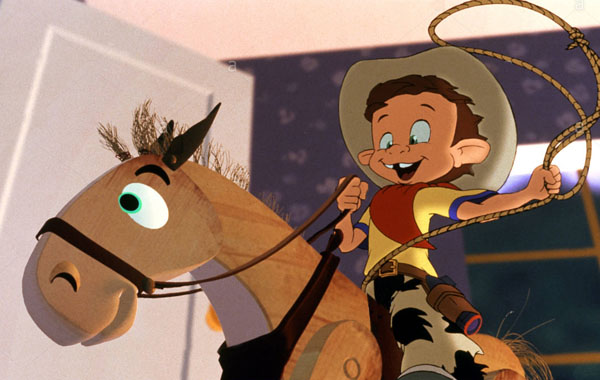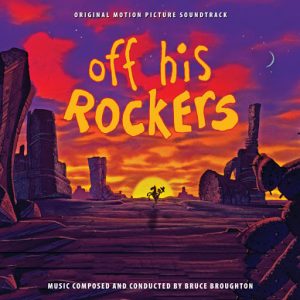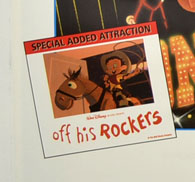
Supsended Animation #268
I got a chance to meet Barry Cook briefly when I first came to Florida in 1996, and he impressed me as a nice guy sincerely interested in animation.
He worked as an effects animator or effects supervisor on several films, such as The Black Cauldron, Oliver & Company, The Little Mermaid, Roller Coaster Rabbit, The Rescuers Down Under and Beauty and the Beast.
However, he had a dream of doing a project that would allow him to demonstrate his skills as an animation director to Disney Feature Animation. He began sketching and taking notes on the idea a few years before he was re-located from California to Florida in 1989.
Off His Rockers evolved into an approximately five-minute animated short created entirely at Walt Disney Animation Florida over a two-year period by people working in their spare time.The cartoon told the story of a young boy who has become so mesmerized by the latest video games that he has abandoned his old playthings, in particular, a talented and clever rocking horse who tries to rescue his friend from the mind-numbing technology.
It is a simple, sweet story with two engaging characters. The short was a combination of hand-drawn animation and computer animation.
“Our goal was to design and animate a film combining hand-drawn and computer-generated images in a fashion that would not call attention to either technique, but instead use the inherent strength of both approaches to provide the ideal characters and settings for the story,” Cook told the press in 1992 when the short was released theatrically.
Cook assembled a core team of about six people to bring the project to life. Eventually, most of the Florida animation staff of 73 people going beyond their job roles donated time to the project on nights and weekends when not working on their assigned projects.
Cook had managed to get Disney to allow the use of Disney resources at the Florida studio for the production as a type of training exercise.
In an interview in the Orlando Sentinel in a July 15, 1992, Cook said that the message of the story was: “In the first place, one should be true to his friends; second, he should be true to himself. The moral is not to let your imagination be taken captive by something else, to use your imagination, That’s what happens in the end. The point is not the video game. The point is the boy can’t think for himself anymore. The machine is doing all the thinking. It’s controlling him.”

The one and only official publicity still for “Off His Rockers”
“The catalyst for the whole idea was the rocking horse itself,” Cook said. “I was thinking ‘what kind of character would contain geometric shapes and be suitable for the level of computer graphics that we wanted to experiment with.’ The horse is made of carved wood and has flat surfaces on the sides and the legs. He looks like he’s cut out of boards.”
Rob Bekuhrs, who was supervising animator for the horse (along with James Tooley), recalled, “The horse was made up of 52 shapes or components, which we would manipulate individually inside the computer. The real challenge was to put emotion into something which would eventually be synthesized into a stream of numbers. The horse didn’t have much elasticity so we had our work cut out for us showing him becoming increasingly animated as the film progresses.”
Alex Kupershmidst was the supervising animator for the hand-drawn animation of the unnamed young boy and came on board simply because he loved to draw.
“It’s really nice to see it up on the screen,” Kupershmidt said. “The thing about Barry [is] he has a pretty strong personality. He gives you an idea of being a very casual person and he is, but underneath that casualness is very strong will and determination.”
Cook said, “Since most of the story takes place in one room of a house, we wanted to do all we could to make it seem interesting. One of the things we did was to create a wallpaper pattern based on a famous Degas painting using a technique called ‘texture mapping.’ We also computer rendered the floor to make it look like hardwood and put a rug on it with a texture map containing coffee stains and spills. I always think of the bigger thing that can happen and sort of shoot for that.”
 Peter Schneider, Disney’s president of feature animation, looked at the rough animation on Off His Rockers and saw its potential. To do the score, he hired Bruce Broughton, the Emmy Award-winning composer who had scored Roller Coaster Rabbit, the animated Roger Rabbit film short produced by Florida animators, and The Rescuers Down Under.
Peter Schneider, Disney’s president of feature animation, looked at the rough animation on Off His Rockers and saw its potential. To do the score, he hired Bruce Broughton, the Emmy Award-winning composer who had scored Roller Coaster Rabbit, the animated Roger Rabbit film short produced by Florida animators, and The Rescuers Down Under.
Tad Gielow, a Disney veteran who had been instrumental for many years in pioneering Disney’s experimentation with new animation technologies, was made the producer. Ric Sluiter was the art director. Additional animation was supplied by Tom Bancroft, Linda Bel and Paul McDonald. Story development was credited to Barry Cook, Paul Steele, Peter Cook and Alex Kupershimdt.
The plan was to release the film with the theatrical re-release in the summer of 1992 of the animated feature Pinocchio. Randal Kleiser, director of Honey, I Blew Up the Kid, the 1992 sequel to Honey, I Shrunk the Kids, viewed the film.
“When he saw the film, he liked it so much he asked Jeffrey Katzenberg (chairman of Walt Disney Studios) if he could have it as the opening to his film instead,” Cook said.
Off His Rockers premiered July 17, 1992, with the live-action feature. The feature received mixed reviews and few audiences saw the charming short.
However, Disney was so pleased with the work that Cook was hired to direct the next Roger Rabbit theatrical short, Trail Mix-Up, released in 1993. On the flume ride in the cartoon is a wanted poster that is just seen briefly but pictures the boy from Off His Rockers.
Peter Schneider told the press in 1992. “Off His Rockers is an important step in (Feature Animation Florida) continuing growth and development and represents the kind of challenging assignments we are constantly looking for to nurture the talents and imaginations of our animators and to push the artistic frontiers of the medium in new directions.”
On March 19th, 2004, Disney decided to close the Florida studio forever. For the last few years, the studio had been working on an innovative animated feature called My Peoples (and sometimes referred to as A Few Good Ghosts).
The film was cancelled and was added to the list of unmade Disney features. Oh, by the way, the director of My Peoples was Barry Cook, and it was based on a story concept he had pitched in 1999. He was not offered a position to remain with the company and relocate back to California. Cook went on to co-direct Arthur Christmas (2011) for Aardman and Sony Animation, among other projects – none since for Disney.




 Jim Korkis is an internationally respected animation historian who in recent years has devoted his attention to the many worlds of Disney. He was a columnist for a variety of animation magazines. With his former writing partner, John Cawley, he authored several animation related books including The Encyclopedia of Cartoon Superstars, How to Create Animation, Cartoon Confidential and Get Animated’s Animation Art Buyer’s Guide. He taught animation classes at the Disney Institute in Florida as well as instructing classes on acting and animation history for Disney Feature Animation: Florida.
Jim Korkis is an internationally respected animation historian who in recent years has devoted his attention to the many worlds of Disney. He was a columnist for a variety of animation magazines. With his former writing partner, John Cawley, he authored several animation related books including The Encyclopedia of Cartoon Superstars, How to Create Animation, Cartoon Confidential and Get Animated’s Animation Art Buyer’s Guide. He taught animation classes at the Disney Institute in Florida as well as instructing classes on acting and animation history for Disney Feature Animation: Florida.




















































I don’t know what “famous Degas painting” was the basis of the wallpaper pattern; it doesn’t look like his style. The painting on the wall in the background is “Still Life with Coffee Pot” by Vincent Van Gogh, from his Arles period. The original is in the Van Gogh Museum in Amsterdam.
If you ask me, it’s Bruce Broughton’s music that really makes this film work.
“The Fish Weren’t Biting Animation Group” — what’s the joke behind that?
I assume it’s a reference to the fact that WD Florida’s studio was informally known as the “The Fishbowl”, since tourists could see inside.
Ah yes, I remember seeing that on TV when the studio opened and thinking it must have been a terrible place to work with all those tourists tapping on the glass and making faces!
What a delight!
It so strongly foreshadows Toy Story – 3 years before we saw that in theaters. Very nice short, and I love the history.